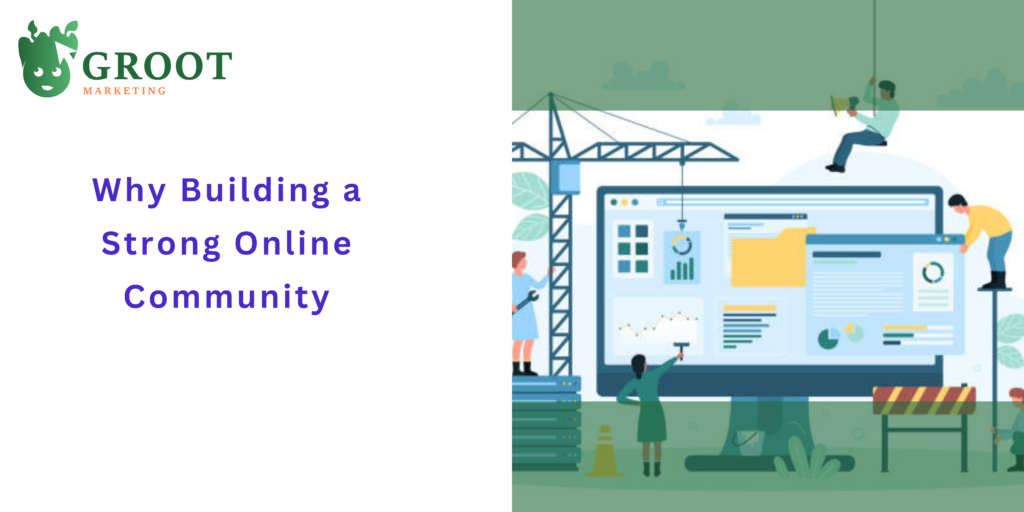In today’s digital marketing world, businesses are no longer just selling products or services; they are building relationships with their customers. With increasing competition in almost every industry, creating a strong online community is a crucial strategy that can differentiate your brand and contribute significantly to its long-term success. In this blog, we will explore the importance of building an online community and share actionable techniques to foster an engaged audience.
Why an Online Community Matters in Digital Marketing?
1. Builds Trust and Loyalty
When customers feel like they are part of a community, they are more likely to trust and stay loyal to your brand. Trust is the cornerstone of any relationship, and a well-nurtured online community can act as a bridge between your brand and its customers. By engaging regularly, addressing concerns, and providing value, you create a space where people feel heard, which leads to stronger loyalty over time.
2. Creates a Feedback Loop
An engaged online community offers valuable feedback that helps brands improve their products, services, or even customer service. Feedback from loyal members of your community can provide you with insights into what your audience truly wants, allowing you to make data-driven decisions and improve customer satisfaction. It’s a powerful and inexpensive way to gather market research.
3. Encourages Word-of-Mouth Marketing
One of the most effective forms of marketing is word-of-mouth, and a community fosters this naturally. When your audience feels connected to your brand, they are more likely to share it with friends, family, or their own social networks. This creates organic growth, increasing your brand’s visibility and attracting new customers without additional advertising spend.ss8s9
4. Enhances Customer Retention
An active online community creates a sense of belonging, and customers are more likely to stick with a brand that fosters such connections. Communities are built on shared values and goals, which increase customer retention as members feel they are part of something bigger than a simple transaction. This sense of belonging can keep customers engaged and reduce churn.
5. Boosts Engagement and Reach
When you have an online community, members are likely to engage more frequently with your content. Whether it’s sharing posts, commenting, or participating in discussions, this increased engagement can improve your brand’s visibility on social media platforms and search engines. Increased engagement not only strengthens your relationship with existing customers but also attracts new ones, expanding your digital footprint.
6. Increases Organic Reach and Visibility
Online communities can significantly extend a brand’s organic reach. When members of a community engage with your content by liking, sharing, or commenting, it often gets shared with their networks, increasing your brand’s visibility to a broader audience. This type of organic reach is invaluable because it feels more authentic and credible compared to paid advertisements.
Additionally, active online communities help boost your brand’s SEO (search engine optimization) efforts. Regular interactions, discussions, and content-sharing in online forums or social media groups create a steady stream of fresh content that search engines favor. The more your brand is mentioned and engaged with across various platforms, the more likely it is to rank higher in search results, driving even more organic traffic to your website.
Techniques for Building and Nurturing an Online Community
Now that we understand why building an online community is essential for your brand’s success, let’s dive into some actionable techniques to create and sustain one.
1. Define Your Community’s Purpose
Before you start building a community, it’s important to define its purpose. Ask yourself: What will your community be about? Is it a space to share knowledge, a place to offer support, or a way to celebrate shared values? Your community’s purpose should align with your brand’s goals and provide value to your audience. For example, if you’re in digital marketing, your community could focus on providing insights and solutions to help small businesses grow.
2. Choose the Right Platform
Choosing the right platform to host your community is key. Depending on your audience, this could be social media platforms like Facebook Groups, LinkedIn, or a private forum on your website. If your community is more visual, Instagram or YouTube could be great platforms for engagement. If you want deeper discussions, consider forums or platforms like Reddit or Discord. Ensure that your chosen platform aligns with where your audience is most active.
3. Engage Consistently
Building a community requires consistent engagement. It’s not enough to set it up and expect it to grow on its own. Be active by posting regularly, responding to comments, and encouraging discussions among members. You can also ask for their opinions through polls, questions, or feedback forms. Regularly share valuable content like blogs, videos, webinars, or behind-the-scenes updates to keep your audience engaged.
4. Provide Value
People join communities to gain something of value—whether it’s knowledge, inspiration, or connection. Make sure your community offers this. Provide exclusive content, resources, or tips that aren’t available elsewhere. Share how-to guides, industry news, or host live Q&A sessions where members can ask questions. By offering value, you’ll attract and retain an engaged audience who see the community as a valuable resource.
5. Encourage User-Generated Content
One of the best ways to foster engagement in your community is by encouraging user-generated content (UGC). This could be in the form of reviews, testimonials, photos, or even blog posts shared by your audience. By encouraging members to contribute, you create a more dynamic and engaging environment where the audience feels more invested in the community.
For example, in a digital marketing community, you could run a campaign asking members to share their digital marketing success stories or challenges, and feature the best submissions. This creates a sense of belonging and gives your members a voice.
6. Host Events and Contests
Another effective way to foster community engagement is by hosting virtual events, such as webinars, live chats, or Q&A sessions. These events offer members the opportunity to learn more about your brand and interact with experts in the field. You can also host contests or challenges to keep the community energized. Prizes don’t have to be extravagant, but offering a small incentive can motivate participation.
7. Celebrate Milestones and Contributions
Publicly acknowledge and celebrate your community’s growth and the contributions of individual members. Whether it’s reaching a membership milestone or highlighting a particularly active member, recognition encourages further participation and helps build a sense of pride among members. A community that celebrates its members fosters deeper engagement and loyalty.
8. Listen and Adapt
Communities are dynamic, and as they grow, the needs and desires of your audience may change. Be sure to actively listen to your community by paying attention to their feedback, monitoring engagement metrics, and making adjustments as necessary. Whether it’s tweaking your content strategy or introducing new features, adapting to the evolving needs of your community will keep it relevant and valuable.
Conclusion: The Long-Term Impact of a Strong Online Community
Building a strong online community is more than just a digital marketing tactic; it’s a long-term strategy that can profoundly impact your brand’s success. By nurturing relationships, fostering engagement, and creating a space where your audience feels valued and connected, you not only strengthen customer loyalty but also gain a wealth of insights and opportunities for growth.
In the world of digital marketing, where trends and algorithms constantly shift, having a dedicated community of loyal followers provides stability and ensures that your brand remains relevant and competitive. Start today by defining your community’s purpose and engaging your audience consistently. Over time, you’ll find that a strong online community is not just a nice-to-have but a key driver of your brand’s success.







